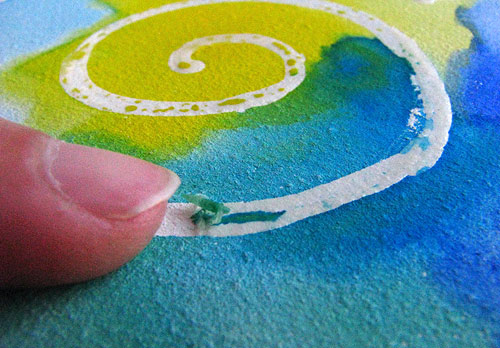To apply frisket, I use a plastic dental toothpick shaped like a not-quite-right-angled “L”. I have a whole plastic container of them that I got at the drugstore. It is wonderful for applying frisket. The short “L” end can lay the frisket down in a narrow ribbon, and the pointed end is obviously useful. The greatest thing is that it wipes of completely clean with tissue or paper towel. The leg of the “L” is about 2 inches, the short part is about 1/2 inch. I’ve tried wooden toothpicks, the pointed wood thing from a catalog, and a crochet hook. None compare to the “L”.
Tip from: Jan Thielemann
With masking fluid, I have found that sometimes a little heavier coverage makes it come off the paper more easily, with less damage. Too light a coating simply soaks in, instead of sitting on the surface. having something to grap the mask makes it easier to take it off gently.
Tip from Susan Tschantz
Lightly rubbing your brush over a bar of soap before using it for masking fluid makes it easier to clean. It gives it a bit of a coating, although it doesn’t last all that long.
Tip from: Sarah James
When you’re using masking fluid, use a cheap, fine brush. Before you dip it into the masking fluid, dip the brush in water and then rub it across a cake of soap. This makes the masking fluid flow easier and longer. Continue working in this way, and the brush cleans right up and you can easily use it again. Tip from: Ruth Sullivan
Wet your brush and apply hand soap before dipping it into masking fluid. It prevents the brush being damaged, and makes the masking fluid wash out easily.
Tip from: Anne Nel
I use an old nail-polish brush to apply masking fluid to my watercolor paper. It goes on easily, washes quickly from the brush, and never dries too rapidly.

Leave a Reply
You must be logged in to post a comment.